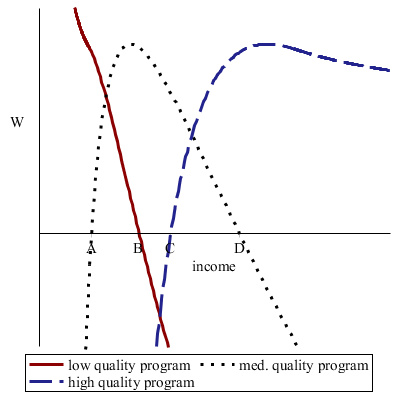Making sure that the benefits of poverty programs most accrue to the poorest possible beneficiaries is difficult. Directly excluding people based on measures of poverty like income, expenditure, or assets is problematic for many reasons: data is difficult to collect, people may misrepresent themselves on surveys to increase benefits, and single “snap-shot” measures may miss out on important dynamic aspects of poverty.
Targeting is easier if programs are “self-targeting,” meaning they incorporate features that lead the poor to opt in and the wealthy to opt out without requiring policy makers to observe who is rich or poor. There are many examples of self-targeting mechanisms, but one is the idea of offering an in-kind transfer of a good that only poor people want, like an inferior staple good (Besley and Coate, 1991; Jacoby, 1997).
In-kind transfers may be appealing for reasons beyond targeting accuracy. For example, transfers in the form of a particular good may be “sticky” in the sense of particularly increasing household expenditure on that good, which paternalistic policymakers may find appealing. In-kind transfers may also be politically palatable if giving food to the poor sounds more appealing than handing out cash. But buying and distributing food poses many logistical challenges: program implementers may not have sufficient information on local markets and preferences to efficiently purchase food that beneficiaries actually want at the lowest cost.
One way to solve these challenges may be to let eligible beneficiaries choose for themselves what they will buy. If a program offers a village the chance to buy a staple good at subsidized rates and lets them choose which staple food their village will buy, the villagers should be able to select the variety of food they prefer and buy it from the seller who offers the best rates.
But will a program that lets villages choose for themselves be self-targeting? If the staple food comes in different qualities or grades, and price is associated with quality, then which households want to participate will depend on which food the village chooses. The figure below shows how this works.

The x-axis shows income and the y-axis shows the surplus utility from buying the subsidized food from the program instead of the food of the household’s choice at market rates. Each line assumes that the village chooses a different variety of food. When the village chooses the cheapest variety available (the red line), the program most appeals to the poor, and everyone with income greater than B drops out. When the program offers the most expensive food (the blue dashed line), only people with income greater than C opt in. In villages that choose the cheap food, this program should be self-targeting, while in villages that choose the expensive rice, we may see elite capture, in the sense that only the wealthiest receive benefits.
So what happens in practice? If we give villages a grant and tell them to use it to buy food to distribute to households as a subsidized loan, what do we see? Given that poor households may value the program the most, do village choices most reflect their preferences? Are the poor or the wealthy most likely to participate in such a program? Check out the paper or a coming blog post to find out.

